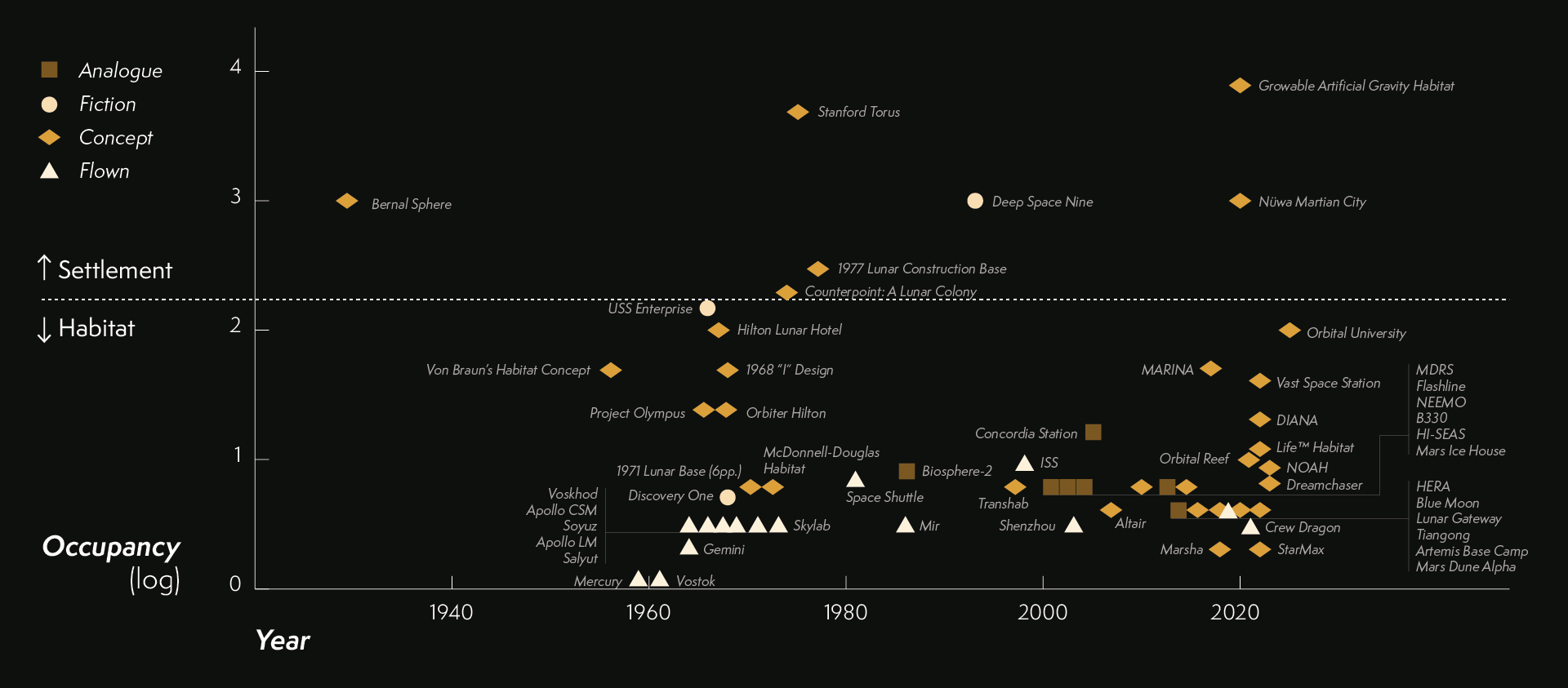Mapping the possibilities of space habitat design
Aurelia’s Space Architecture Trade Study offers a deep dive on the current state of concepts and feasibility, as well as a resource for researchers and designers
The Aurelia team recently completed the first phase of our Space Architecture Trade Study, a first-of-its-kind deep dive review of a broad array of habitat papers, concepts, and designs for space. The goal of the project is to assess past and current designs for space stations and other structures, while evaluating the feasibility of concept designs for future builds.
The Trade Study seeks to understand the current state of space habitat development: What are the ideas on the table? What designs and concepts overlap, and what are the outliers? Of the designs that have been tried, which have succeeded and why? What is the feasibility of the concepts that haven’t yet been built, and are they worth pursuing in the future?
Trade Study
Leading the project are Dr. Annika Rollock and Dr. Danielle DeLatte. Annika began her work with Aurelia as an intern last year while completing her PhD, and has since come aboard as our Director of Engineering. Annika is the lead author, along with Danielle and Dr. Ariel Ekblaw, of a paper presenting the findings from the first phase of the project, “A Methodology for the Systematic Review of Space Architecture Concepts,” published this summer by the International Conference on Environmental Systems.
The paper describes the methodology behind the study as well as the initial results from examining different aspects of 100+ architectural designs, including their habitable volume, occupancy, proposed location, and year of design. Though it is still ongoing, this work has been documented in an open-source database that has been well-received by the broader space architecture and human spaceflight communities. From this work, Annika and the Trade Study research team will systematically analyze gaps between current technology and future concepts in order to guide future research and development, both for Aurelia and the broader space architecture community.
Figure from the ICES paper plotting space habitat concepts’ occupancy over time.
Key Takeaways
The majority of space habitats to date have been designed and constructed, understandably, to meet survival and mission needs rather than optimized for physiological, psychological, or experiential flourishing of the human occupants
However, throughout recent history, there has been interest in city-scale space habitats that represent a significant departure from the standard survivalist, cylindrical habitats and posit a more expansive range of experiences and values for day to day life
Despite the rapid increase in commercial space activity and a surge of new, prospective space stations, we still need to see more industry focus to close the gap between traditional design and construction methods (primarily linked pressure cylinders) and more creative, future-leaning concepts that could scale to hold hundreds of civilians.
The database itself represents a significant step forward as a resource for researchers and engineers, designers and architects, students, artists, and enthusiasts. We hope it will serve as a jumping-off point for further investigation, as well as a tool and an inspiration for people working across technology and creative sectors.
Looking Forward
Following the broad survey of the trade study, the team identified three case study concepts that merited further deep dives. Each case study is looking at an interesting gap from the trade study: a single, self-assembling station module; a variable artificial gravity station; and a station collective that could grow organically over time. The team is beginning with our own TESSERAE, conducting a concept design review using the Trade Study rubric to map the project’s user base and real-life scenarios against the feasibility of its design, structure and materials, technology, and goals. The case study will be published upon completion, and will serve as a roadmap for TESSERAE’s next phases of development.
And in other news at Aurelia
This October, the Aurelia team is getting out there to represent our work and participate in the thriving space community. A few spotlights:
Aurelia, Axiom, and Boryung are co-hosting Humans in Space, a global challenge launched by healthcare investment company Boryung calling for innovative solutions and research on the challenges of sustained human life in space. Finalists of the Humans in Space innovation challenge will present their pitches onstage during a Symposium on October 23-25, co-located at the ASCEND Space Conference.
Learn more.
Also at ASCEND 2023, AIAA’s premiere space event, Ariel Ekblaw is participating on the panels “Next-Generation Space Habitats” and “Founders Panel.” View the full program.
Earlier in October, Ariel will be speaking at the Economist Space Summit and attending the XPRIZE Visioneering 2023 Conclave. In November, Danielle DeLatte will join the Space Habitats and Exploration Panel at the International Mechanical Engineering Congress & Exposition (IMECE).
And finally, the Aurelia team is hard at work preparing our Fall 2023 Academy offerings—stay tuned for details, and sign up here to indicate interest and be notified when enrollment opens!






